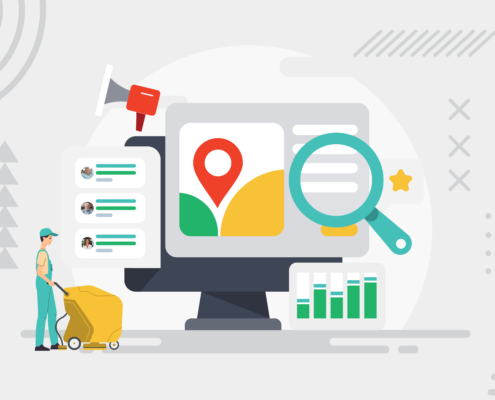

What do baked potatoes and french fries have in common? While they’re both potatoes, they’re obviously prepared differently, right? But nonetheless, they’re both still potatoes, but with different purposes.
The same concept can be said about lead generation and appointment setting. While they both achieve the same goal of business growth, the way they’re approached is different based on your use for them and your target market.
Throughout this blog, we’ll cover the core differences between lead generation and appointment setting, from what they are and the process that goes into each business growth strategy. Let’s get into it.
What Is Lead Generation?
Lead generation services are marketing strategies and activities aimed at identifying prospects and attracting potential customers (leads) who have shown interest in a company’s products or services. These services employ various techniques such as cold calling, email marketing, content marketing, social media marketing, search engine optimization, paid advertising, and lead capture forms to gather information about individuals or businesses that might have a need for what the company offers. The collected data typically includes contact details like email addresses, phone numbers, and company names.
Why are Lead Generation Services Important?
Lead generation is vital for businesses because it forms the foundation of their sales funnel. It provides a steady stream of potential customers who have already expressed some level of interest in what the company offers. These leads are more likely to be receptive to marketing and sales efforts, making the conversion process more efficient and cost-effective.
By utilizing lead generation services, businesses can:
- Expand their customer base and reach a broader audience
- Improve sales and revenue by targeting interested prospects
- Enhance marketing ROI by focusing resources on potential customers
- Establish a database of valuable customer information for future marketing campaigns
When to Consider Lead Generation Services
Lead generation is a non-stop activity for growing businesses. So even when you are working on a deal or starting a project, it’s important to keep the lead gen engine running for a growing business.
Therefore, businesses should consider implementing lead generation services into their everyday operations when they aim to boost sales and revenue. Lead generation helps identify potential customers interested in their products or services. It becomes crucial when the company wants to scale its customer base, expand market reach, or launch new offerings.
Additionally, businesses in competitive industries should adopt lead generation to stay ahead. It enables targeted marketing efforts, reducing wasted resources on uninterested prospects. By generating high-quality leads, companies can nurture relationships, increase conversion rates, and ultimately drive sustainable growth.
For more insight into lead generation services, read our blog here.
What Does the Typical Lead Generation Process Look Like?
The typical lead generation process involves a series of stages and strategies aimed at identifying and attracting potential customers or leads who have shown interest in a company’s products or services.
Here is an overview of the typical lead generation process:
Step 1. Identifying Target Audience
In lead generation, establishing your target audience, followed by your Ideal Customer Profile (ICP) is crucial. This step entails precisely defining the characteristics, demographics, interests, and behaviors of the desired audience. By understanding the audience’s unique traits and preferences, businesses can tailor their marketing efforts to attract and engage prospects who are more likely to become valuable customers.
Step 2. Creating Relevant Content
Content marketing is pivotal in lead generation. It involves crafting informative and tailored content, such as blog posts, ebooks, videos, or webinars, that resonates with the target audience’s interests and needs. This content not only attracts potential leads but also establishes the business as an authority in its field, fostering trust and engagement.
Step 3. Promotion and Distribution
Promotion is diverse, spanning social media, email marketing, SEO, paid ads, and even outreach methods like cold calling, emailing, and social selling. The objective is to cast a wide net, making the content easily discoverable by potential leads. These channels amplify the reach, ensuring that the content resonates with the right audience and entices them to engage and provide their information.
Step 4. Lead Capture
Businesses employ lead capture forms and landing pages to turn website visitors into leads. These forms usually request essential contact details, like email addresses, in exchange for access to exclusive content or special offers. This strategy not only generates leads but also provides a clear value proposition to potential customers.
Step 5. Lead Nurturing
Lead nurturing is a critical step after obtaining contact information. It involves a series of personalized and targeted communications, such as emails and newsletters, designed to build trust and maintain engagement with leads. By providing valuable content and addressing their specific needs, businesses keep leads interested and move them closer to conversion.
Step 6. Lead Scoring and Qualification
Lead scoring and qualification are essential for efficiency. Businesses assess leads based on their engagement and alignment with the ideal customer profile. High-scoring leads, indicating strong interest and fit, are prioritized for personalized sales efforts. This approach optimizes resource allocation and increases the likelihood of successful conversions.
Step 7. Handoff to Sales
Sales readiness triggers a seamless transition to the sales team. At this stage in the lead generation process, the lead has shown a strong interest and potential for conversion. The sales team takes over, engaging in tailored outreach, including appointment setting or product demonstrations, to capitalize on the lead’s readiness and drive toward closing a deal.
Step 8. Conversion
Conversion is the culmination of the lead generation process. Businesses aim to turn leads into paying customers by employing persuasive sales strategies and effective negotiations. This phase focuses on addressing customer needs, demonstrating value, and guiding prospects toward making a purchase, ultimately achieving the primary objective of revenue generation.
Step 9. Measurement and Analysis
Data and analytics are integral for the continuous improvement of the lead generation process. They provide insights into the performance of lead generation efforts, enabling businesses to gauge what’s working and what needs refinement. By analyzing metrics like conversion rates and engagement levels, companies can fine-tune their strategies, ensuring maximum efficiency and better outcomes.
Step 10. Feedback Loop
Continuous improvement is driven by feedback and analysis. The sales team’s input, along with ongoing data analysis, informs iterative enhancements to lead generation strategies. This dynamic process ensures that the approach remains effective, adapts to changing market conditions, and consistently delivers improved results in attracting and converting leads into customers.
Read our blog here for complete insight into the B2B lead generation process from beginning to end.
What are Appointment Setting Services?
B2B appointment setting services are specialized sales and marketing activities designed to facilitate and schedule meetings or appointments between a business (the selling entity) and other businesses (potential clients or partners). These services are crucial for B2B organizations as they focus on establishing direct, one-on-one interactions with key decision-makers or stakeholders in target companies. The primary aim is to qualify and engage these prospects in meaningful conversations that can lead to mutually beneficial partnerships, contracts, or sales agreements.
Why are Appointment Setting Services Important?
Appointment setting services are essential for several reasons, including:
- They streamline the sales process by ensuring that sales reps spend their time engaging with qualified leads who are ready to invest in their product or services.
- They enable businesses to reach the right individuals within their target companies, ensuring that decision-makers are involved in the purchasing process.
- These services help build strong relationships with potential clients by providing opportunities for personalized communication and understanding their specific needs.
- They are a cost-effective way to acquire new clients or partners since resources are allocated to engaging with pre-qualified prospects.
- They increase the likelihood of conversion into actual business deals because they focus on getting sales meetings rather than general marketing practices.
Considering hiring an appointment setter? Here are some reasons why hiring an appointment setter could be your next business move.
What Does the Typical Appointment Setting Process Look Like?
The typical B2B appointment setting process involves several steps and strategies aimed at scheduling meetings or appointments between a business and potential clients or partners.
Here’s an overview of the typical B2B appointment setting process:
Step 1. Identify Target Businesses
Prospecting initiates the process by strategically pinpointing businesses that closely match the company’s goals and offerings. Criteria for ideal clients or partners are meticulously established, ensuring that valuable resources are directed toward engaging prospects with the highest potential for successful appointments.
Step 2. Outbound Lead Generation
Outbound lead generation involves proactive outreach to potential leads through cold calls or emails. Networking events and trade shows provide opportunities for in-person connections and lead acquisition, in addition to your strategic prospecting efforts. Leads may originate from in-house databases, purchased lists, or organic sources like website inquiries or referrals, broadening the lead pool for appointment setting efforts.
Step 3. Initial Contact
Business development representatives (BDRs) or appointment setters employ various channels, such as cold calls, personalized emails, social media outreach, and even LinkedIn connections, to establish initial contact. Their goal is to capture the prospect’s attention and initiate the appointment setting process.
Step 4. Lead Qualification
During the lead qualification stage, prospects and leads are carefully assessed to confirm their alignment with specific criteria, including decision-making authority, budget availability, and genuine interest in the company’s offerings. By focusing on high-potential prospects, businesses ensure that their appointment setting efforts are optimized for success and conversion.
Step 5. Appointment Pitch
The appointment setters articulate the company’s value proposition, emphasizing the benefits of scheduling a meeting. The pitch is tailored to address the prospect’s unique needs or challenges, highlighting how the meeting can provide solutions and create value for the prospect’s business.
Step 6. Appointment Confirmation
When a prospect expresses interest, a mutually convenient date and time for the appointment are determined and confirmed. Crucial details, including the meeting agenda and location, are communicated to both parties, ensuring a seamless and productive interaction between the company and the prospect.
Step 7. Meeting Preparation
Here, the company conducts thorough research to gather essential insights into the prospect’s needs, pain points, and preferences. This information guides the customization of the presentation or proposal, ensuring it directly addresses the prospect’s specific requirements and maximizes the chances of a favorable outcome.
Step 8. Sales Meeting or Presentation Held
The sales appointment is the core interaction because it’s what ideally converts the sales opportunity into a sale. During this phase, the sales team or representatives actively engage in a conversation, presentation, or product/service demonstration. The primary objective is to provide valuable information, address questions or concerns, and strategically guide the prospect toward making a decision that aligns with their needs and benefits the company.
Step 9. Follow-Up
Follow-up is crucial for maintaining momentum. A structured strategy is executed post-meeting to address any outstanding inquiries, furnish supplementary details, and facilitate discussions regarding the next course of action. This reinforces communication and fosters a collaborative environment, enhancing the likelihood of successful outcomes and conversions.
Step 10. Conversion
Conversion is the ultimate goal of the appointment setting process. The objective is to transition the appointment into a successful outcome, which could be a sale, partnership, or any other desired agreement. Negotiations and discussions may persist until a mutually beneficial arrangement is reached, solidifying the business relationship.
Step 11. Measurement and Analysis
Metrics like appointment success rates and conversion rates are scrutinized to gauge performance. These insights inform ongoing adjustments and refinements to the appointment setting strategy, ensuring it remains aligned with business objectives and maximizes success in securing appointments and conversions.
Step 12. Feedback Loop
Lastly, in the appointment setting process, insights gathered from the sales team and prospects provide valuable input for enhancing the appointment setting process. This iterative approach ensures that the strategy stays effective, aligns with evolving business objectives, and continually adapts to meet the needs of both the company and its prospects.
Read our blog here to learn how you can build and sustain a predictable B2B appointment setting process.
What’s the Difference Between Lead Generation and Appointment Setting Services?
In short, appointment setting is a sector of lead generation, but lead generation does not equate to appointment setting. There are some overlaps between the two business growth strategies.
Generally speaking, there are four core differences between lead generation and appointment setting services: goal, strategy, process, and influence.
The Goals They Aim to Achieve
Lead Generation: The primary goal of lead generation is to identify and attract potential customers or leads who have shown interest in a company’s products or services. It aims to create a broad pool of leads.
Appointment Setting: The primary goal of B2B appointment setting is to schedule one-on-one meetings or appointments between the company and potential clients or partners. It aims to move leads from the marketing and lead generation funnel down to the sales funnel.
The Strategy Behind How to Generate Sales
Lead Generation: The strategy for lead generation often involves casting a wider net through various marketing channels like content marketing, social media, SEO, and paid advertising. The focus is on capturing contact information and creating a database of leads.
Appointment Setting: The strategy for appointment setting involves identifying and targeting specific businesses or individuals within those businesses who are decision-makers or key stakeholders. It requires personalized outreach and engagement to secure appointments.
The Process of Moving a Lead Down the Sales Funnel
Lead Generation: Lead generation aims to attract and gather a wide range of potential leads or prospects who have actively shown interest in a company’s products or services. The primary outcome of lead generation is a list of potential leads with their contact details, which can be used for ongoing marketing and nurturing efforts.
Appointment Setting: B2B appointment setting is a more focused goal that aims to schedule one-on-one meetings or appointments between the company’s representatives and qualified leads who have expressed a higher level of interest and potential to become customers or partners. The primary outcome of B2B appointment setting is successful appointments scheduled with qualified prospects, with the intention of moving them further down the sales funnel and potentially closing deals.
The Influence it Has on Business Growth
Lead Generation: The influence of lead generation is primarily on creating awareness, attracting prospects, and gathering contact information for future marketing and nurturing efforts. Metrics related to lead generation include lead volume, lead source effectiveness, and conversion rates from leads to opportunities.
Appointment Setting: The influence of appointment setting is on deeper engagement and moving leads closer to conversion. It plays a crucial role in turning leads into sales opportunities or partnerships. Metrics related to B2B appointment setting include appointment success rates, conversion rates from appointments to deals, and the overall impact on revenue generation.

What Works Best for My Business: Lead Generation or Appointment Setting Services?
Weighing the pros and cons of lead generation vs. appointment setting services? Deciding between lead generation and appointment setting depends on a company’s specific goals, target audience, industry, resources, and sales cycle. Here are steps to help companies determine what works best for their business:
- Set Clear Objectives: Define your primary goals. If the goal is to increase awareness and build a broad lead database, lead generation may be the focus. If the goal is to close deals or secure partnerships, appointment setting may be more appropriate.
- Know Your Target Audience: Understand your ideal customers or clients. If your audience prefers one-on-one interactions, appointment setting may be crucial. For broader audiences, lead generation may be sufficient.
- Assess Resources: Evaluate your team’s capabilities, resources, and bandwidth. Appointment setting often requires more personalized outreach and may need dedicated sales representatives. Lead generation can be more automated.
- Consider Industry and Sales Cycle: Some industries and longer sales cycles benefit from relationship-building through appointments. Others may rely on high-volume lead generation and follow-up.
- Test and Measure: Conduct A/B testing or pilot programs to assess which strategy yields better results. Measure metrics like conversion rates, ROI, and revenue generated.
- Combine Strategies: In many cases, a combination of both lead generation and appointment setting can be effective. Start with lead generation to build a pool of prospects, then use appointment setting to engage high-potential leads.
- Market Dynamics: Consider market conditions, competition, and trends. Your approach may need to adapt based on external factors.
- Customer Feedback: Listen to customer feedback. It can provide insights into their preferences and how they want to engage with your business.
- Consult Experts: Seek advice from industry experts or consultants who specialize in lead generation and appointment setting to tailor your approach to your specific needs.
- Iterate and Evolve: Continuously evaluate and adapt your strategy. Market dynamics change, and what works best for your business may evolve over time.
Ultimately, the decision should align with your business’s unique goals and circumstances. It’s important to be flexible and willing to adjust your strategy as needed to achieve the best results.
Abstrakt provides B2B companies with a wide range of lead generation and appointment setting services to help them build their pipelines. Explore our approach to B2B lead generation here.
Why Should I Include Appointment Setting in My Lead Generation Strategy?
Companies should consider including B2B appointment setting in their lead generation strategy because it takes lead nurturing to the next level. While lead generation captures contact information, appointment setting nurtures relationships through personalized interactions.
By scheduling one-on-one meetings with qualified leads, businesses can engage in in-depth discussions, address specific needs, and build trust. This human touch increases the likelihood of conversion and fosters valuable partnerships.
B2B appointment setting complements lead generation by transforming leads into opportunities, expediting the sales cycle, and maximizing the return on investment, making it a vital component of a holistic and effective sales and marketing strategy.
Reasons to Outsource Lead Generation and Appointment Setting Services
Outsourcing lead generation and appointment setting services can offer several benefits to companies looking to grow their book of business, including:
- They often specialize in both lead generation and appointment setting, bringing a high level of expertise and experience to the table
- They are cost-effective as it eliminates the need to hire, train, and maintain an in-house team, reducing labor and infrastructure costs
- They allow companies to focus on their core business activities while outsourcing non-core functions, leading to improved efficiency
- They empower companies to scale their operations as needed because they can easily adjust the level of services based on their needs and growth
- They have access to advanced tools and technologies needed for lead generation and appointment setting
- They can tap into a global talent pool and reach markets and prospects that may be otherwise inaccessible
- They assume certain risks associated with lead generation and appointment setting, allowing companies to mitigate potential issues
- They can start implementing your strategy quickly, avoiding the time and effort needed to set up an in-house team from scratch
- They provide detailed performance metrics and reporting, allowing companies to track results effectively
While outsourcing has its advantages, companies should carefully select reputable outsourcing partners and maintain effective communication to ensure alignment with their goals and objectives.
Key Takeaways
Baked potatoes and french fries; lead generation and appointment setting. They’re all the same. The first two examples have the intention of being eaten, while lead generation and appointment setting both aim to generate more sales. Lead generation and appointment setting may have similar concepts, but the way they’re approached should be different based on your target market, the overall goals you want to achieve, and many more examples that we expanded on above.
Lead generation and appointment setting is not a one-and-done business growth solution. It requires consistent action to get the results that you want. And it takes a lot of time, money, and resources in order to get a positive ROI. When businesses don’t have the bandwidth to take it on in-house, that’s when they consider outsourcing to sales and marketing firms. And that’s where we come in.
At Abstrakt, we work with growing B2B businesses across the United States to help them fill their sales pipelines through outsourced lead generation and B2B appointment setting services. We have a proven process for both that has allowed us to generate consistent streams of revenue for our clients. When you’re ready to get the most out of your lead generation and appointment setting efforts, contact the sales experts at Abstrakt!




